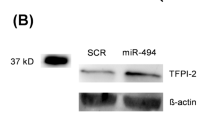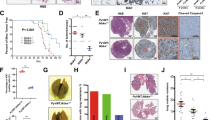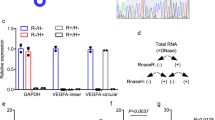Abstract
Sustained urokinase-type plasminogen activator (uPA) expression is detected in aggressive breast tumors. Although uPA can be transiently upregulated by diverse extracellular stimuli, sustained, but not transiently upregulated uPA expression contributes to breast cancer invasion/metastasis. Unfortunately, how sustained uPA expression is achieved in invasive/metastatic breast cancer cells is unknown. Here, we show that sustained and transiently upregulated uPA expression are regulated by distinct mechanisms. Using a collection of transcription factor-targeted small-interfering RNAs, we discovered that interleukin enhancer-binding factor 3 (ILF3) is required for sustained uPA expression. Two discrete mechanisms mediate ILF3 action. The first is that ILF3 activates uPA transcription by binding to the CTGTT sequence in the nucleotides −1004∼−1000 of the uPA promoter; the second is that ILF3 inhibits the processing of uPA mRNA-targeting primary microRNAs (pri-miRNAs). Knockdown of ILF3 led to significant reduction in in vitro cell growth/migration/invasion and in vivo breast tumor development. Importantly, immunohistochemistry (IHC) showed that nuclear ILF3, but not cytoplasmic ILF3 staining correlates with elevated uPA level and higher grades of human breast tumor specimens. Nuclear localization of ILF3 highlights the role of ILF3 in sustained uPA expression as a transcription activator and pri-miRNA processing blocker. In conclusion, this study shows that ILF3 promotes breast tumorigenicity by regulating sustained uPA expression.
This is a preview of subscription content, access via your institution
Access options
Subscribe to this journal
Receive 50 print issues and online access
$259.00 per year
only $5.18 per issue
Buy this article
- Purchase on Springer Link
- Instant access to full article PDF
Prices may be subject to local taxes which are calculated during checkout







Similar content being viewed by others
References
Blasi F . Proteolysis, cell adhesion, chemotaxis, and invasiveness are regulated by the u-PA-u-PAR-PAI-1 system. Thromb Haemost 1999; 82: 298–304.
Blasi F, Carmeliet P . uPAR: a versatile signalling orchestrator. Nat Rev Mol Cell Biol 2002; 3: 932–943.
Duffy MJ, Maguire TM, McDermott EW, O’Higgins N . Urokinase plasminogen activator: a prognostic marker in multiple types of cancer. J Surg Oncol 1999; 71: 130–135.
Annecke K, Schmitt M, Euler U, Zerm M, Paepke D, Paepke S et al. uPA and PAI-1 in breast cancer: review of their clinical utility and current validation in the prospective NNBC-3 trial. Adv Clin Chem 2008; 45: 31–45.
Harbeck N, Kates RE, Schmitt M, Gauger K, Kiechle M, Janicke F et al. Urokinase-type plasminogen activator and its inhibitor type 1 predict disease outcome and therapy response in primary breast cancer. Clin Breast Cancer 2004; 5: 348–352.
Mazumdar A, Adam L, Boyd D, Kumar R . Heregulin regulation of urokinase plasminogen activator and its receptor: human breast epithelial cell invasion. Cancer Res 2001; 61: 400–405.
Dunn SE, Torres JV, Oh JS, Cykert DM, Barrett JC . Up-regulation of urokinase-type plasminogen activator by insulin-like growth factor-I depends upon phosphatidylinositol-3 kinase and mitogen-activated protein kinase kinase. Cancer Res 2001; 61: 1367–1374.
Johnson MD, Torri JA, Lippman ME, Dickson RB . Regulation of motility and protease expression in PKC-mediated induction of MCF-7 breast cancer cell invasiveness. Exp Cell Res 1999; 247: 105–113.
Crippa MP . Urokinase-type plasminogen activator. Int J Biochem Cell Biol 2007; 39: 690–694.
Mahanivong C, Yu J, Huang S . Elevated urokinase-specific surface receptor expression is maintained through its interaction with urokinase plasminogen activator. Mol Carcinog 2007; 46: 165–175.
Noh H, Hong S, Dong Z, Pan ZK, Jing Q, Huang S . Impaired microRNA processing facilitates breast cancer cell invasion by upregulating urokinase-type plasminogen activator expression. Genes Cancer 2011; 2: 140–150.
Aguirre Ghiso JA, Alonso DF, Farias EF, Gomez DE, de Kier Joffe EB . Deregulation of the signaling pathways controlling urokinase production. Its relationship with the invasive phenotype. Eur J Biochem 1999; 263: 295–304.
Kao PN, Chen L, Brock G, Ng J, Kenny J, Smith AJ et al. Cloning and expression of cyclosporin A- and FK506-sensitive nuclear factor of activated T-cells: NF45 and NF90. J Biol Chem 1994; 269: 20691–20699.
Corthesy B, Kao PN . Purification by DNA affinity chromatography of two polypeptides that contact the NF-AT DNA binding site in the interleukin 2 promoter. J Biol Chem 1994; 269: 20682–20690.
Shi L, Godfrey WR, Lin J, Zhao G, Kao PN . NF90 regulates inducible IL-2 gene expression in T cells. J Exp Med 2007; 204: 971–977.
Duchange N, Pidoux J, Camus E, Sauvaget D . Alternative splicing in the human interleukin enhancer binding factor 3 (ILF3) gene. Gene 2000; 261: 345–353.
Reichman TW, Parrott AM, Fierro-Monti I, Caron DJ, Kao PN, Lee CG et al. Selective regulation of gene expression by nuclear factor 110, a member of the NF90 family of double-stranded RNA-binding proteins. J Mol Biol 2003; 332: 85–98.
Kiesler P, Haynes PA, Shi L, Kao PN, Wysocki VH, Vercelli D . NF45 and NF90 regulate HS4-dependent interleukin-13 transcription in T cells. J Biol Chem 2010; 285: 8256–8267.
Kuwano Y, Kim HH, Abdelmohsen K, Pullmann R, Martindale JL, Yang X et al. MKP-1 mRNA stabilization and translational control by RNA-binding proteins HuR and NF90. Mol Cell Biol 2008; 28: 4562–4575.
Kuwano Y, Pullmann R, Marasa BS, Abdelmohsen K, Lee EK, Yang X et al. NF90 selectively represses the translation of target mRNAs bearing an AU-rich signature motif. Nucleic Acids Res 2010; 38: 225–238.
Vumbaca F, Phoenix KN, Rodriguez-Pinto D, Han DK, Claffey KP . Double-stranded RNA-binding protein regulates vascular endothelial growth factor mRNA stability, translation, and breast cancer angiogenesis. Mol Cell Biol 2008; 28: 772–783.
Pei Y, Zhu P, Dang Y, Wu J, Yang X, Wan B et al. Nuclear export of NF90 to stabilize IL-2 mRNA is mediated by AKT-dependent phosphorylation at Ser647 in response to CD28 costimulation. J Immunol 2008; 180: 222–229.
Sakamoto S, Aoki K, Higuchi T, Todaka H, Morisawa K, Tamaki N et al. The NF90-NF45 complex functions as a negative regulator in the microRNA processing pathway. Mol Cell Biol 2009; 29: 3754–3769.
Fung LF, Lo AK, Yuen PW, Liu Y, Wang XH, Tsao SW . Differential gene expression in nasopharyngeal carcinoma cells. Life Sci 2000; 67: 923–936.
Guo NL, Wan YW, Tosun K, Lin H, Msiska Z, Flynn DC et al. Confirmation of gene expression-based prediction of survival in non-small cell lung cancer. Clin Cancer Res 2008; 14: 8213–8220.
Guo Y, Fu P, Zhu H, Reed E, Remick SC, Petros W et al. Correlations among ERCC1, XPB, UBE2I, EGF, TAL2 and ILF3 revealed by ovarian cancer. Oncol Rep 2012; 27: 286–292.
Guan D, Altan-Bonnet N, Parrott AM, Arrigo CJ, Li Q, Khaleduzzaman M et al. Nuclear factor 45 (NF45) is a regulatory subunit of complexes with NF90/110 involved in mitotic control. Mol Cell Biol 2008; 28: 4629–4641.
Price JE, Polyzos A, Zhang RD, Daniels LM . Tumorigenicity and metastasis of human breast carcinoma cell lines in nude mice. Cancer Res 1990; 50: 717–721.
Bandyopadhyay A, Zhu Y, Cibull ML, Bao L, Chen C, Sun L . A soluble transforming growth factor beta type III receptor suppresses tumorigenicity and metastasis of human breast cancer MDA-MB-231 cells. Cancer Res 1999; 59: 5041–5046.
Foekens JA, Peters HA, Look MP, Portengen H, Schmitt M, Kramer MD et al. The urokinase system of plasminogen activation and prognosis in 2780 breast cancer patients. Cancer Res 2000; 60: 636–643.
Dass K, Ahmad A, Azmi AS, Sarkar SH, Sarkar FH . Evolving role of uPA/uPAR system in human cancers. Cancer Treat Rev 2008; 34: 122–136.
Almholt K, Lund LR, Rygaard J, Nielsen BS, Dano K, Romer J et al. Reduced metastasis of transgenic mammary cancer in urokinase-deficient mice. Int J Cancer 2005; 113: 525–532.
Watabe T, Yoshida K, Shindoh M, Kaya M, Fujikawa K, Sato H et al. The Ets-1 and Ets-2 transcription factors activate the promoters for invasion-associated urokinase and collagenase genes in response to epidermal growth factor. Int J Cancer 1998; 77: 128–137.
Sliva D, English D, Lyons D, Lloyd FP . Protein kinase C induces motility of breast cancers by upregulating secretion of urokinase-type plasminogen activator through activation of AP-1 and NF-kappaB. Biochem Biophys Res Commun 2002; 290: 552–557.
Das R, Mahabeleshwar GH, Kundu GC . Osteopontin stimulates cell motility and nuclear factor kappaB-mediated secretion of urokinase type plasminogen activator through phosphatidylinositol 3-kinase/Akt signaling pathways in breast cancer cells. J Biol Chem 2003; 278: 28593–28606.
Das R, Mahabeleshwar GH, Kundu GC . Osteopontin induces AP-1-mediated secretion of urokinase-type plasminogen activator through c-Src-dependent epidermal growth factor receptor transactivation in breast cancer cells. J Biol Chem 2004; 279: 11051–11064.
Chen H, Zhu G, Li Y, Padia RN, Dong Z, Pan ZK et al. Extracellular signal-regulated kinase signaling pathway regulates breast cancer cell migration by maintaining slug expression. Cancer Res 2009; 69: 9228–9235.
Amorino GP, Hamilton VM, Valerie K, Dent P, Lammering G, Schmidt-Ullrich RK . Epidermal growth factor receptor dependence of radiation-induced transcription factor activation in human breast carcinoma cells. Mol Biol Cell 2002; 13: 2233–2244.
Vanden BW, Dijsselbloem N, Vermeulen L, Ndlovu MN, Boone E, Haegeman G . Attenuation of mitogen- and stress-activated protein kinase-1-driven nuclear factor-kappaB gene expression by soy isoflavones does not require estrogenic activity. Cancer Res 2006; 66: 4852–4862.
Han Q, Leng J, Bian D, Mahanivong C, Carpenter KA, Pan ZK et al. Rac1-MKK3-p38-MAPKAPK2 pathway promotes urokinase plasminogen activator mRNA stability in invasive breast cancer cells. J Biol Chem 2002; 277: 48379–48385.
Li H, Ye X, Mahanivong C, Bian D, Chun J, Huang S . Signaling mechanisms responsible for lysophosphatidic acid-induced urokinase plasminogen activator expression in ovarian cancer cells. J Biol Chem 2005; 280: 10564–10571.
Mahanivong C, Chen HM, Yee SW, Pan ZK, Dong Z, Huang S . Protein kinase Calpha-CARMA3 signaling axis links Ras to NF-kappaB for lysophosphatidic acid-induced urokinase plasminogen activator expression in ovarian cancer cells. Oncogene 2008; 27: 1273–1280.
Huang S, Chakrabarty S . Expression of antisense fibronectin RNA in human colon carcinoma cells disrupts the regulation of carcinoembryonic antigen by transforming growth factor beta 1. J Biol Chem 1994; 269: 28764–28768.
Li Y, Kimura T, Huyck RW, Laity JH, Andrews GK . Zinc-induced formation of a coactivator complex containing the zinc-sensing transcription factor MTF-1, p300/CBP, and Sp1. Mol Cell Biol 2008; 28: 4275–4284.
Su S, Li Y, Luo Y, Sheng Y, Su Y, Padia RN et al. Proteinase-activated receptor 2 expression in breast cancer and its role in breast cancer cell migration. Oncogene 2009; 28: 3047–3057.
McCarty KS, Miller LS, Cox EB, Konrath J, McCarty KS . Estrogen receptor analyses. Correlation of biochemical and immunohistochemical methods using monoclonal antireceptor antibodies. Arch Pathol Lab Med 1985; 109: 716–721.
Acknowledgements
This work was supported by funding from NIH CA093926 (SH), NSF of China Fund 81 073 134 (SBS) and Shanghai Eastern Scholar Fund (SH). We would like to thank Dr Michael Mathews for providing ILF3 splicing isoform constructs.
Author information
Authors and Affiliations
Corresponding author
Ethics declarations
Competing interests
The authors declare no conflict of interest.
Additional information
Supplementary Information accompanies the paper on the Oncogene website
Supplementary information
Rights and permissions
About this article
Cite this article
Hu, Q., Lu, YY., Noh, H. et al. Interleukin enhancer-binding factor 3 promotes breast tumor progression by regulating sustained urokinase-type plasminogen activator expression. Oncogene 32, 3933–3943 (2013). https://doi.org/10.1038/onc.2012.414
Received:
Revised:
Accepted:
Published:
Issue Date:
DOI: https://doi.org/10.1038/onc.2012.414
Keywords
This article is cited by
-
Characterization of circSCL38A1 as a novel oncogene in bladder cancer via targeting ILF3/TGF-β2 signaling axis
Cell Death & Disease (2023)
-
Signaling of MK2 sustains robust AP1 activity for triple negative breast cancer tumorigenesis through direct phosphorylation of JAB1
npj Breast Cancer (2021)
-
Upregulation of ERp57 promotes clear cell renal cell carcinoma progression by initiating a STAT3/ILF3 feedback loop
Journal of Experimental & Clinical Cancer Research (2019)
-
Phosphodiesterase 7B/microRNA-200c relationship regulates triple-negative breast cancer cell growth
Oncogene (2019)
-
Intragenic antagonistic roles of protein and circRNA in tumorigenesis
Cell Research (2019)



